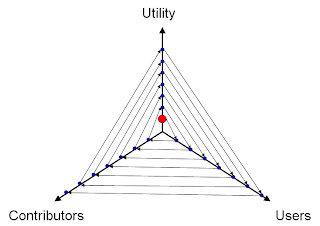It’s been over a year since we created the Gene Wiki, and nine months since the effort was published. We previously blogged about the vision as it relates to the Long Tail, and many others have written about the effort too.
 So one year later, how does one retrospectively assess the success of the Gene Wiki? In my mind, all community intelligence efforts are dependent on creating a positive feedback loop between utility, users, and contributors.
So one year later, how does one retrospectively assess the success of the Gene Wiki? In my mind, all community intelligence efforts are dependent on creating a positive feedback loop between utility, users, and contributors.
The idea goes something like this. A resource that has some baseline level of utility will attract some number of users over time. Some percentage of users will actually stay long enough to contribute. That contribution can be something as trivial as fixing a typo or as substantial as summarizing a recent paper. Regardless, that contribution makes the resource better, which then draws more users and then a larger core of contributors. Efforts that are able to complete this positive feedback loop grow, while those that don’t end up stagnating.
With that in mind, how does the Gene Wiki stack up?
- Utility: This one is hardest to measure since there are no quantitative metrics. Certainly our goal was to create stubs with useful content mined from existing structured databases. Perhaps that the paper was the seventh-most read PLoS Biology paper in all of 2008 is the best indication of utility.
- Users: In any given one-month period, the 9000+ pages in the Gene Wiki are viewed millions of times. For example, would you have guessed that the CD44 page was viewed 4251 times last month? (See the full access stats for November 2008.) The usage patterns suggest that the Gene Wiki is being used by both scientists and lay people. Adding to our optimism for future growth, we find that eighty-six percent of Gene Wiki pages show up on the first page of Google when searched by gene symbol (up from sixty-six percent when the paper was first published).
- Contributors: In 2008, 15,255 edits were made by 3590 unique users or IP addresses. (An additional 31,865 edits were made by 85 automated “bots”.) All these edits translate to an average increase of 236 kb of text content per month to the Gene Wiki, roughly the equivalent of 27 research letters in Nature. (Credit to Pierre for writing the program to assemble these metrics.)
Overall, we’re pretty confident that the Gene Wiki satisfies the positive feedback loop described above, and that there is a solid critical mass on which the effort can grow. So have you edited the page on your favorite gene yet?
